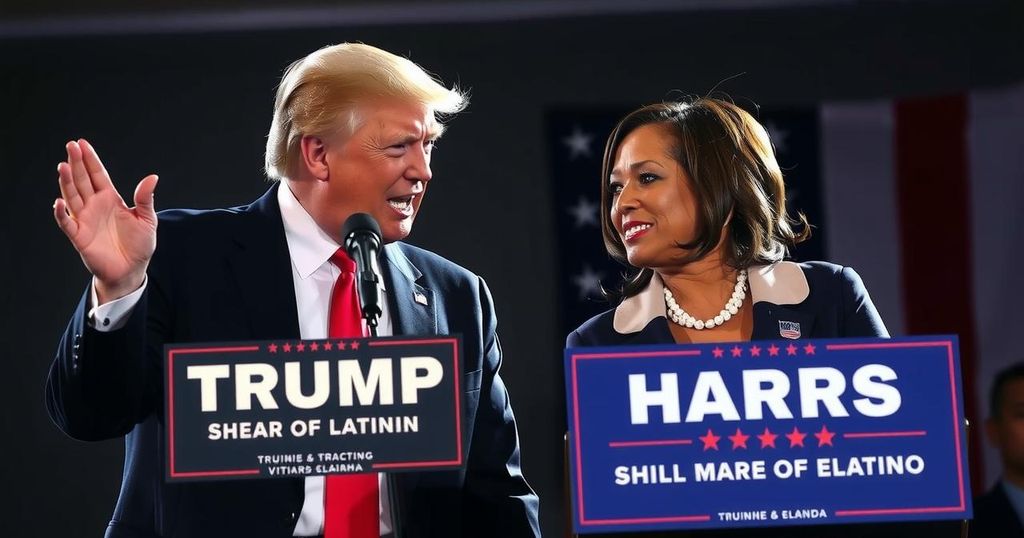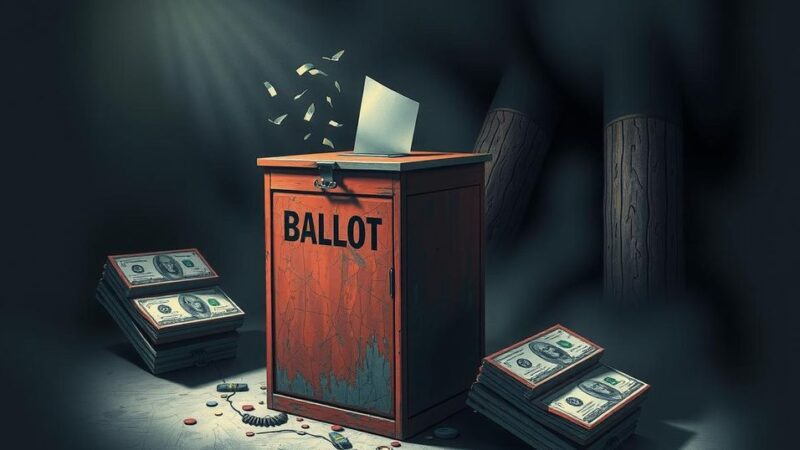With Election Day imminent, both Donald Trump and Kamala Harris have intensified their campaigns to attract the Latino vote, which constitutes 14.7% of eligible voters. Trump, campaigning in battleground states, focuses on issues like immigration, while Harris emphasizes economic concerns and unity amidst controversies surrounding Trump’s remarks. The shifting allegiances of Latino voters play a crucial role in determining the election results, particularly in key states like New Mexico, Arizona, and Nevada.
In the run-up to the Election Day, scheduled in just five days, former President Donald Trump and Vice President Kamala Harris have intensified their efforts to secure the Latino vote across several southwestern states. According to research from the Pew Research Center, Latino voters represent approximately 14.7% of all eligible voters in the upcoming election. New Mexico, where Mr. Trump engaged voters on Thursday, boasts the largest percentage of Latino individuals, comprising nearly 45% of its population. Additionally, California, Texas, Arizona, and Nevada follow closely behind in their Latino demographics. Although California consistently supports Democratic candidates and Texas leans Republican, Arizona and Nevada are considered pivotal swing states, with significant influence on the overall election outcome. Historically, the Democratic Party has enjoyed a considerable advantage among Latino voters; however, as per a national poll conducted by NBC News, Telemundo, and CNBC in September, this lead has been narrowing over the past four presidential elections. A notable shift has occurred, particularly among Latino men, largely attributed to growing concerns about inflation and the rising cost of living, where voters reportedly place more trust in Mr. Trump compared to Ms. Harris. At a rally in Albuquerque, New Mexico, Mr. Trump remarked, “So I’m here for one simple reason. I like you very much, and it’s good for my credentials with the Hispanic or Latino community,” urging attendees not to make him “waste a whole damn half a day here.” He expressed confidence in capturing New Mexico’s electoral votes, stating, “We almost won it twice, and let me tell you, I believe we won it twice,” implying that he suspected electoral fraud during the previous elections. Furthermore, he asserted, “One of the biggest reasons we will win this state is that you have among the worst border problems of any state in America, and I am the only one that knows how to fix it.” However, Mr. Trump’s campaign faced backlash due to a controversy instigated by comedian Tony Hinchcliffe, who made racist comments regarding Latino individuals at a rally hosted by Mr. Trump in Madison Square Garden. While campaign officials moved swiftly to dissociate Mr. Trump from these remarks, the former President still has not publicly addressed the issue. While immigration and border security took center stage during Mr. Trump’s speech, a recent CNBC poll cited these topics as the fourth most pressing concern among Latino voters, trailing behind issues such as inflation, job opportunities, and threats to democracy. A notable trend is that more Latino individuals today believe immigration benefits the country, although this sentiment has seen its lowest ratio since 2006. Conversely, Vice President Harris held rallies in Phoenix, Arizona, and in Reno and Las Vegas, Nevada, where her focus was on an economic platform while indirectly criticizing Mr. Trump’s immigration policies. She stated, “With five days left in this campaign, my opponent is also making his closing argument to America. It is an argument full of hate and division,” accusing him of scapegoating immigrants and warning of the potential return of family separation policies. Ms. Harris was also joined by influential Latino musicians, including singer Jennifer Lopez, who underscored her Puerto Rican heritage and resonated with immigrant communities while introducing the Vice President. Lopez stated, “[Trump] has consistently worked to divide us. At Madison Square Garden, he reminded us who he really is and how he really feels.” Both political figures have ramped up outreach initiatives aimed at Latino voters as the election date approaches. Mr. Trump hosted a roundtable discussion with Latino business leaders in Florida, and Telemundo featured a pre-recorded interview with Ms. Harris, showcasing their commitment to engaging with this demographic as Election Day draws near.
As Election Day approaches, both Donald Trump and Kamala Harris have made concerted efforts to appeal to Latino voters, a significant demographic that historically leans Democratic but has shown signs of decreasing support for the party. With Latino voters making up 14.7% of the total eligible voting populace, their influence is critical in key battleground states, especially New Mexico, Arizona, and Nevada. Concerns surrounding the economy, particularly inflation, have reshaped voter preferences and loyalty, leading Trump to focus campaign themes on economic distress while grappling with controversies that could impact voter sentiment.
In conclusion, Trump and Harris are actively vying for the crucial Latino vote as they approach Election Day. While Trump seeks to leverage demographic shifts and economic concerns to gain ground, Harris counters with a focus on unity and a strong economic pitch. The contrasting messages of both campaigns reflect the evolving priorities of Latino voters and demonstrate the significance of this demographic in the upcoming election’s outcome.
Original Source: www.cnbc.com






